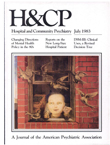Clinical Applications of DSM-III in Consultation-Liaison Psychiatry
Abstract
The authors examine the clinical application of DSM-lII from the perspective of the consultation-liaison psychiatrist. They discuss contributions of DSM-III that have refined psychiatric diagnosis in medical-surgical settings, induding the multiaxial system, a broaderapproach to the organic mental disorders, introduction of the category of psychological factors affecting physical condition, and an improved class, fication of disorders that present with physical symptoms. However, some areas of continuing ambiguity remain, such as bow much discretion a clinician has to discount somatic symptoms related to physical illness in the diagnosis ofdepression, the implications of exempting bereavement from diagnostic status, and uncertainty about what constitutes evidence of an etiological relationship.
Access content
To read the fulltext, please use one of the options below to sign in or purchase access.- Personal login
- Institutional Login
- Sign in via OpenAthens
- Register for access
-
Please login/register if you wish to pair your device and check access availability.
Not a subscriber?
PsychiatryOnline subscription options offer access to the DSM-5 library, books, journals, CME, and patient resources. This all-in-one virtual library provides psychiatrists and mental health professionals with key resources for diagnosis, treatment, research, and professional development.
Need more help? PsychiatryOnline Customer Service may be reached by emailing [email protected] or by calling 800-368-5777 (in the U.S.) or 703-907-7322 (outside the U.S.).



